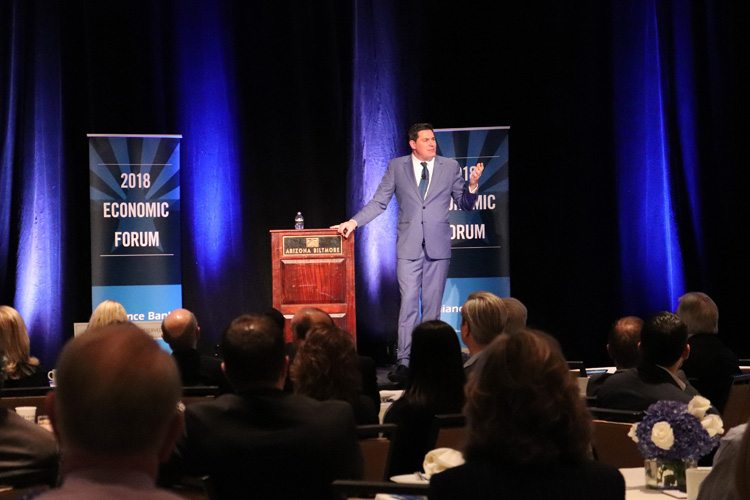Arizona continues to be a star of the U.S. economy, with economic activity growth in Ariz. exceeding growth across the country, according to a Regional Intelligence Report presented last week at the Alliance Bank of Arizona 2018 Economic Forum by notable economist Dr. Christopher Thornberg.
Population growth is responsible for much of the increase in Ariz.’s economic activity. From 2016 to 2017, the state’s population increased by 1.6 percent, well ahead of the nation’s growth rate of 0.7 percent. At the same time, employment increased at an even faster rate of 12.6 percent, well above the 9.3 percent growth in nonfarm employment for the nation as a whole.
The expansion of the statewide economy has fueled growth across many of the state’s industries, including real estate. Nearly every industry of the Ariz. economy is adding jobs in Ariz. each month as nonfarm employment statewide increased by 2.2 percent from Jan. 2017 to Jan. 2018, with the state’s unemployment rate falling 0.2 percentage points to 5.1 percent in that time.
In percentage terms, mining and construction led the state in job growth at 8.3 percent (12,300 jobs) from Jan. 2017 to Jan. 2018, with nearly all of that growth coming in construction (12,100 jobs). This was followed by a 4.9 percent increase in manufacturing employment (7,900 jobs). Education and health services tied as the third-fastest-growing industries in percentage terms, at 3.5 percent, with the highest overall gain in jobs, at 14,800, most of which came from healthcare. High-paying and prominent industries grew with professional and business services employment increasing by 1.3 percent (5,500 jobs).
Other notable findings of the report:
• Tourism: Ariz.’s tourism activity has bolstered employment growth in leisure and hospitality, with 2.8 percent of employment growth (8,600 jobs) from Jan. 2017 to Jan. 2018. Tourism indicators in the state have generally shown improvement in recent years. From Dec. 2016 to Dec. 2017, gross sales from tourism in Ariz. increased by 4.6 percent, national park visitation increased by 9.1 percent and state park visitation increased by 10.3 percent.
• Phoenix-Metro Jobs: With 2.1 million jobs in Jan. 2018, the Phoenix-metro area accounted for nearly three-quarters of the state’s 2.8 million jobs overall. With 4.7 million residents, it also accounts for the lion’s share of the state’s 7-million residents. It should be no surprise that the Phoenix-area economy is tracking closely with the performance of the state economy. Employment has been increasing steadily, the unemployment rate is falling (at 4.5 percent in Jan. 2018), and wages are climbing. In looking at the composition of the local economy, the trade, transportation and utilities industries have the greatest number of jobs in Phoenix metro. However, the high-skilled, high-wage financial activities and professional/business service industries each have higher concentrations of jobs in the Phoenix labor market relative to the U.S. This suggests a regional advantage for these industries. Likewise, mining, construction, leisure and hospitality also have higher concentrations of jobs in the Phoenix economy than in the U.S., giving those industries competitive advantages locally.
• Taxable Sales: Job growth combined with wage growth translates to higher demand for goods and services. In Phoenix metro, taxable sales increased by 4.7 percent from Dec. 2016 to Dec. 2017. Gas prices are on the rise nationwide, while leisure and hospitality spending remains strong. As a result, even though retail sales have experienced only moderate growth (2.9 percent), hotel/motel (12.6 percent), gasoline (12.5 percent), and restaurant and bars (12.4 percent), spending increased substantially from Dec. 2016 to Dec. 2017.
• Residential Real Estate: With such a strong and robust labor market, how is the Phoenix-metro residential real estate market keeping up? The region’s existing single-family median home price stood at $246,700, increasing 6.0 percent (vs. 5.6 percent nationally) from 2016 to 2017. Affordability is roughly on par with the nation as a whole. Across the U.S., the existing single-family median home price stood at $248,800. The median household income in the Phoenix is estimated at $59,500, compared to $59,000 across the country. In terms of rentals, just over one-third (38.3 percent) of households in Phoenix metro are renters. Apartment rents increased by 3.5 percent from 2016 to 2017. Arizona’s other major metros offer a mixed picture regarding multifamily trends.
• Commercial Real Estate: The Phoenix-metro commercial real estate market has been expanding in recent years in response to continued growth in local industries. From 2016 to 2017, the average office rent increased by 2.1 percent to $2.11 per-square-foot monthly, while the office vacancy rate remained relatively stable at 22.4 percent, a decrease of only 0.4 percentage points in that time. The average retail rent increased by 3.0 percent to $1.89 per-square-foot monthly, while the retail vacancy rate remained roughly flat at 8.8 percent. Economic growth has prompted commercial construction growth in the Phoenix area. In Maricopa County, permit values increased by 89 percent from the fourth quarter of 2016 to the fourth quarter of 2017. Total commercial permit values were $5 million in the fourth quarter of 2016, but $9.5 million in the fourth quarter of 2017.
Further details can be found in the Regional Intelligence Report, prepared by Beacon Economics LLC and presented by Alliance Bank of Arizona at the organization’s inaugural economic forum.
To download the full version of the Regional Intelligence Report, visit https://goo.gl/eKS2Qg.




